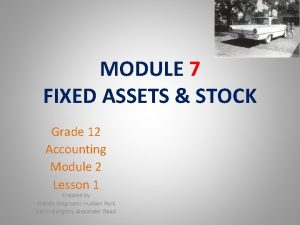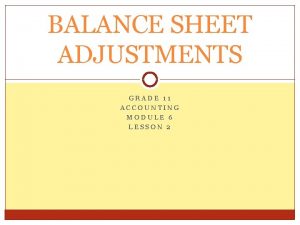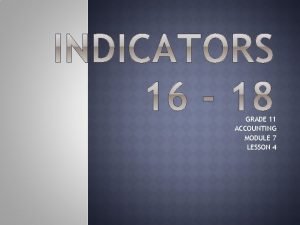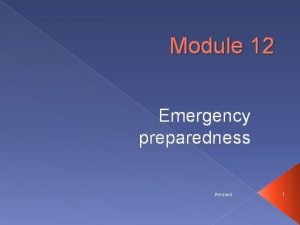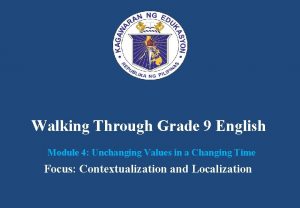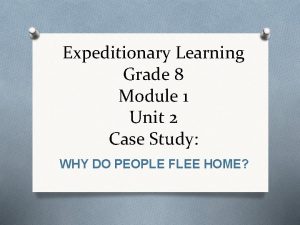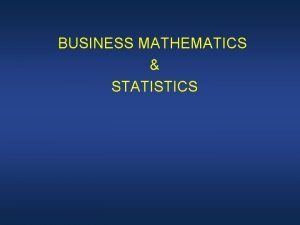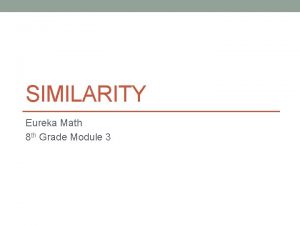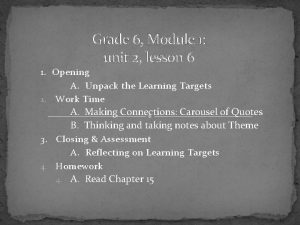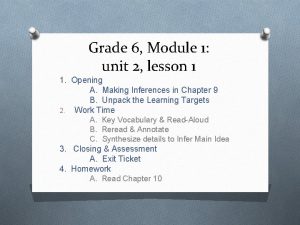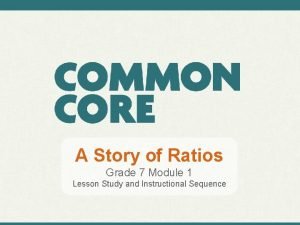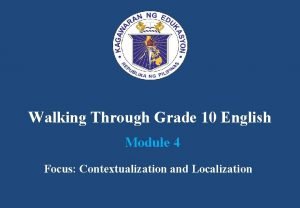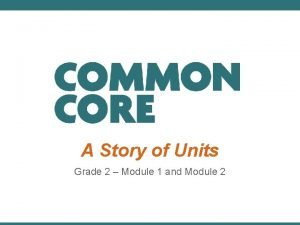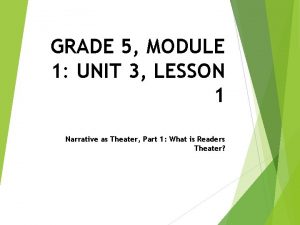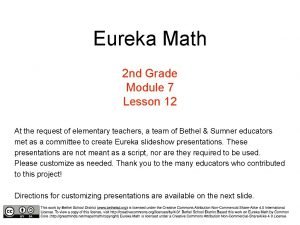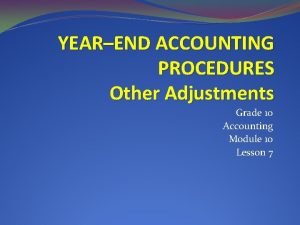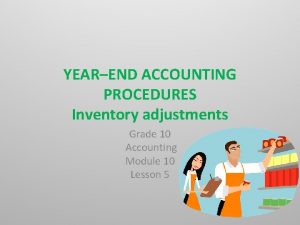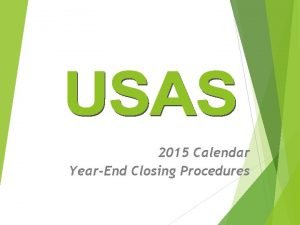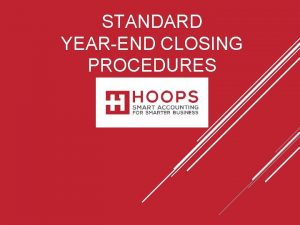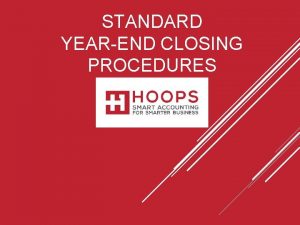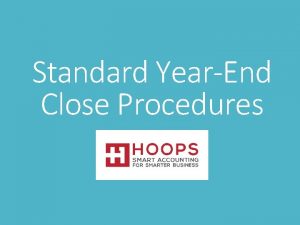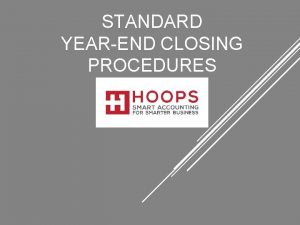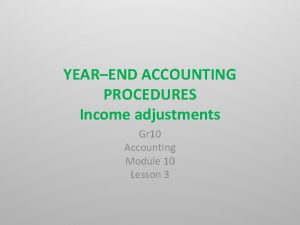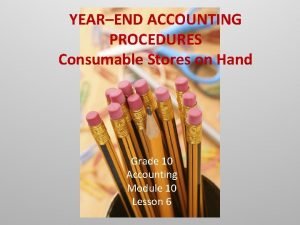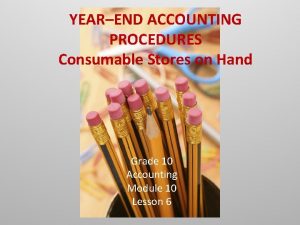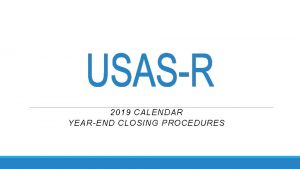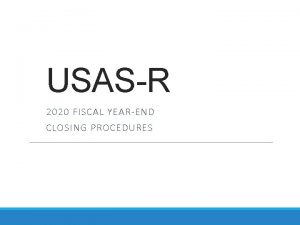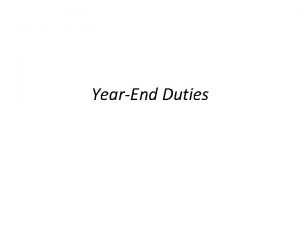YEAREND ACCOUNTING PROCEDURES Grade 10 Accounting Module 10



















- Slides: 19

YEAR–END ACCOUNTING PROCEDURES Grade 10 Accounting Module 10 Lesson 1

The accounting process • Transaction Source Document Journal Ledger Trial Balance • The Trial Balance does not indicate how profitable the business is – it merely consists of a list of balances of the various ledger accounts which is used to check the double entry principle. • In order to determine the profitability of a business a new set of accounts need to be drawn up: – Trading account – Profit and Loss account

The accounting process • Before final accounts are drawn up, it is necessary to take adjustments into account. • Adjustments are entries not considered when the Trial Balance is drawn up. • Adjustments are made to ensure the matching principle is complied with. • The double entry principle applies to adjustments and they are recorded by means of General Journal entries. • Postings are done to relevant accounts and an adjusted Trial Balance is drawn up. • This Trial Balance is called the POST-ADJUSTMENT TRIAL BALANCE. • The Trial Balance that is drawn up before adjustments have been considered is called the PRE-ADJUSTMENT TRIAL BALANCE.

YEAR-END accounting process • • Pre-adjustment Trial Balance Journal entries for adjustments Post to the Ledger Post-adjustment Trial Balance

Definition & Methods of DEPRECIATION Gr 10 Accounting

DEPRECIATION DEFINITION The business uses its fixed assets and they therefore lose value. The amount by which an asset decreases in value is called depreciation. Depreciation is an imputed expense account. It is an adjustment which is calculated at the end of the year to show a realistic version of the books according to the matching principle. The method and rate of depreciation is decided when the business is established.

DEPRECIATION DEFINITION Take note: • only equipment and vehicles are depreciated; land buildings are generally not subject to depreciation • depreciation does not involve the outflow of cash

ACCUMULATED DEPRECIATION DEFINITION It is the account which shows all the depreciation of a particular asset until the asset is totally written off or sold. It can be seen as a provision for depreciation. The account is credited when the depreciation account is debited. This account is seen as a negative asset account which allows you to work out the book value of the asset. Book value = Cost price – Accumulated depreciation

DEPRECIATION METHODS 1. FIXED INSTALMENT METHOD/STRAIGHT LINE METHOD Depreciation is calculated; • in equal amounts over the useful life of the asset • according to a certain number of years (life span) or percentage of the fixed asset. At the end of the assets life span, its book value will be ONE.

DEPRECIATION METHODS FIXED INSTALMENT METHOD/STRAIGHT LINE METHOD Examples; 1. Vehicles with a cost price of R 100 000 are written off over 5 years using the straight line method. Depreciation = R 100 000 ÷ 5 = R 20 000

DEPRECIATION METHODS FIXED INSTALMENT METHOD/STRAIGHT LINE METHOD Examples; Equipment with a cost price of R 10 000 is written off at 20% per annum using the straight line method. Year Cost price Rate Depreciation Acc Dep + Accumulated Depreciation Cost price value - Acc Carrying Dep 20. 0 R 10 000 20% R 2 000 R 8 000 20. 1 R 10 000 20% R 2 000 R 4 000 R 6 000 20. 2 R 10 000 20% R 2 000 R 6 000 R 4 000 20. 3 R 10 000 20% R 2 000 R 8 000 R 2 000 20. 4 R 10 000 20% R 1 999 R 9 999 R 1

DEPRECIATION METHODS 2. DIMINISHING METHOD Depreciation is calculated; • Each year on the reducing book value • Book value = cost – accumulated depreciation • It is generally accepted that depreciation be calculated to the nearest Rand

DEPRECIATION METHODS 2. DIMINISHING METHOD Examples: Equipment with a cost price of R 10 000 is written off at 10% per annum using the diminishing method. Year Cost price Rate Depreciation Acc Dep + Accumulated Depreciation Cost price value - Acc Carrying Dep 20. 0 R 10 000 10% R 1 000 R 9 000 20. 1 R 10 000 10% R 900 R 1 900 R 8 100 20. 2 R 10 000 10% R 810 R 2 710 R 7290 20. 3 R 10 000 10% R 729 R 3 439 R 6561 20. 4 R 10 000 10% R 656 R 4 095 R 5905 • etc

Recording DEPRECIATION Grade 10 Accounting Module 10 Lesson 2

RECORDING DEPRECIATION Example : Fixed Installment A Arty, trading as Arty’s Suppliers, started his business on 1 March 2008. On the first day (1 March 2009) of the second year of trading, Arty’s Suppliers will have the following balances in their General Ledger: Vehicles R 150 000 Equipment R 80 000 Accumulated depreciation on vehicles R 30 000 Accumulated depreciation on equipment R 12 000 On 28 February 2010, the end of the financial year, provision for depreciation must be made as follows: • vehicles at 20% p. a. according to the fixed instalment method • equipment at 15% p. a. according to the diminishing method

RECORDING DEPRECIATION JOURNAL GENERAL JOURNAL Debit Depreciation Credit 40 200 Accumulated depreciation on vehicles 30 000 Accumulated depreciation on equipment 10 200 Depreciation on vehicles: R 150 000 x 20% Depreciation on equipment: (R 80 000 – R 12 000) x 15% = R 30 000 = R 10 200

RECORDING DEPRECIATION: LEDGER GENERAL LEDGER VEHICLES Mar 01 Balance bd 150 000 EQUIPMENT Mar 01 Balance bd 80 000 DEPRECIATION Feb 28 Acc Dep on Vehicles GJ 30 000 Acc Dep on Equipment GJ 10 200

RECORDING DEPRECIATION: LEDGER GENERAL LEDGER ACCUMULATED DEPRECIATION ON VEHICLES Feb 28 Balance cd 60 000 Mar 01 Balance Feb 28 Depreciation bd 30 000 GJ 30 000 60 000 Mar 1 Balance bd 60 000 bd 12 000 GJ 10 200 ACCUMULATED DEPRECIATION ON EQUIPMENT Feb 28 Balance cd 22 200 Mar 01 Balance Feb 28 Depreciation 22 200 Mar 1 Balance bd 22 200

RECORDING DEPRECIATION ASSETS = OWNER’S EQUITY + LIABILITIES - R 30 000 0 - R 12 000 -R 12 000 0 • Depreciation is an imputed expense – thus OE decreases • Acc depreciation is a negative asset – thus assests decrease
 New era accounting grade 12 memo pdf module 1
New era accounting grade 12 memo pdf module 1 Grade 11 balance sheet
Grade 11 balance sheet Grade 11 accounting module 1
Grade 11 accounting module 1 Module 12 emergency procedures
Module 12 emergency procedures C device module module 1
C device module module 1 Chapter 2 analyzing transactions answer key
Chapter 2 analyzing transactions answer key Manual accounting information system
Manual accounting information system Grade 9 english module 4 answer key
Grade 9 english module 4 answer key Principles of marketing grade 11 module 2 answer key
Principles of marketing grade 11 module 2 answer key Expeditionary learning grade 8
Expeditionary learning grade 8 Proportion in business
Proportion in business 1:4 scale
1:4 scale Grade 6, module 1: unit 2 answer key
Grade 6, module 1: unit 2 answer key Eureka math grade 6 module 1 lesson 1
Eureka math grade 6 module 1 lesson 1 A story of ratios
A story of ratios Example of contextualization and localization
Example of contextualization and localization Story of units
Story of units Grade 5 module 1 lesson 1
Grade 5 module 1 lesson 1 Eureka math 3rd grade module 7
Eureka math 3rd grade module 7 Reading and writing module 6
Reading and writing module 6
